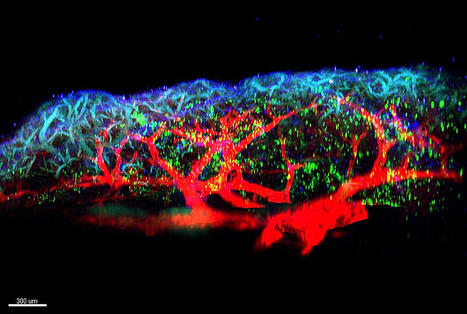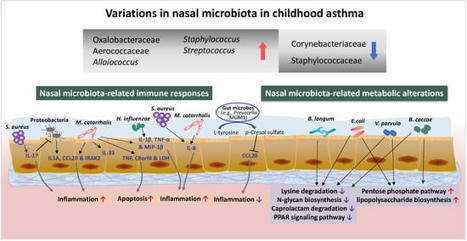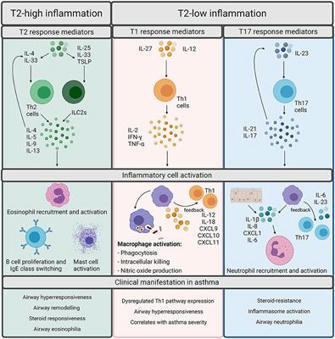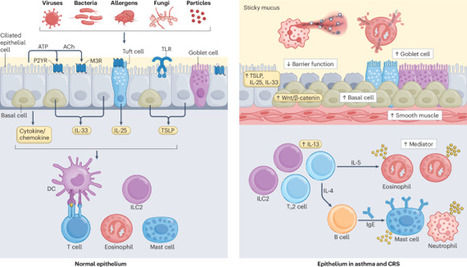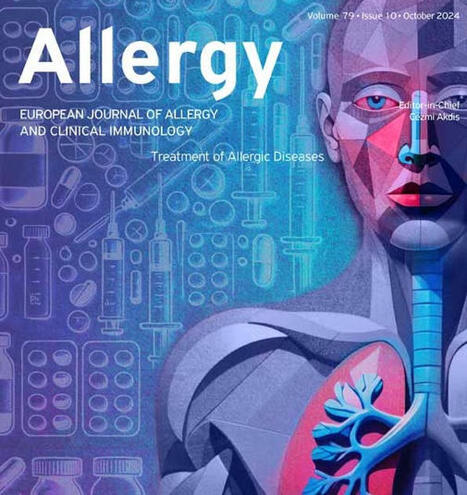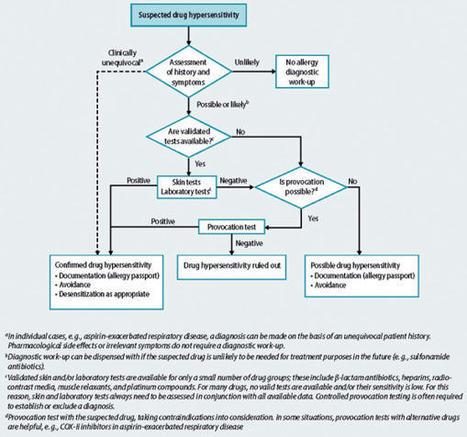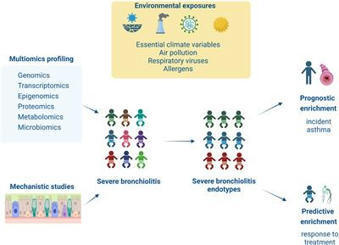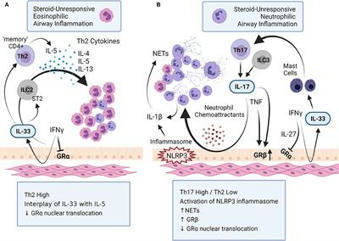 Your new post is loading...
 Your new post is loading...

|
Scooped by
Gilbert C FAURE
August 7, 3:35 AM
|
"A blog about allergy, asthma & immunology"

|
Scooped by
Gilbert C FAURE
May 24, 2:13 AM
|
📢 One of the most appreciated/liked articles in the social media of Allergy published in 2024:
Open Access: Navigating the evolving landscape of atopic dermatitis: Challenges and future opportunities: The 4th Davos declaration. Claudia Traidl-Hoffmann
Read the article here: doi.org/10.1111/all.16247
With over 170 references and 6 figures, this article summarizes the key points discussed during the Global Allergy Forum in Davos. During this event, scientific experts and stakeholders met to address the increasing prevalence of #atopicdermatitis (AD). Topics covered include: #epithelialbarrier maintenance and disturbances in atopic diseases; #environmental changes as a driving force of atopic diseases; immunological march along the course of AD; neuroimmunology, systemic inflammation and comorbidities; therapeutic, educational, and global economic aspects; future directions
Read more articles published in #Allergy on #asthma here: https://lnkd.in/dvHaYziZ
#Allergy_journal

|
Scooped by
Gilbert C FAURE
January 19, 10:43 AM
|

|
Scooped by
Gilbert C FAURE
November 30, 2024 1:45 PM
|

|
Scooped by
Gilbert C FAURE
April 18, 2024 6:08 AM
|
The inflammation process plays a crucial role in allergic respiratory diseases, such as asthma and allergic rhinitis. Although the pulmonary epithelium, the carpet of cells that forms the inner surface of the lungs, is recognized as a major player in the respiratory inflammation that causes these diseases, the underlying mechanisms are still poorly understood.

|
Scooped by
Gilbert C FAURE
February 11, 2024 6:41 AM
|
An overactive population of natural killer cells in children with eczema may worsen skin damage and provoke allergic sensitivity or development of asthma.

|
Scooped by
Gilbert C FAURE
January 16, 2024 1:13 PM
|

|
Scooped by
Gilbert C FAURE
January 5, 2024 1:16 PM
|
"A blog about allergy, asthma & immunology"

|
Scooped by
Gilbert C FAURE
October 30, 2023 11:03 AM
|
The following is a summary of “Evidence-based use of antihistamines for treatment of allergic conditions,” published in the October 2023 issue of Allergy, Asthma & Immunology by Linton, et al. H1 antihistamines have been used to treat allergic diseases like allergic rhinitis and hives since the...

|
Scooped by
Gilbert C FAURE
August 13, 2023 2:51 AM
|
OBJECTIVE: Sublingual immunotherapy (SLIT) has been widely applied to treat patients with allergic rhinitis (AR). However, meta-analyses on th

|
Scooped by
Gilbert C FAURE
March 11, 2023 12:04 PM
|

|
Scooped by
Gilbert C FAURE
December 18, 2022 7:22 AM
|
Childhood asthma is a major chronic non-communicable disease in infants and children, often triggered by respiratory tract infections. The nasal cavity is a reservoir for a broad variety of commensal microbes and potential pathogens associated with respiratory illnesses including asthma.

|
Scooped by
Gilbert C FAURE
December 10, 2022 1:53 AM
|
Asthma is a heterogeneous, chronic respiratory disease affecting 300 million people and is thought to be driven by different inflammatory endotypes influenced by a myriad of genetic and environmental factors. The complexity of asthma has rendered it challenging to develop preventative and disease modifying therapies and it remains an unmet clinical need. Whilst many factors have been implicated in asthma pathogenesis and exacerbations, evidence indicates a prominent role for respiratory viruses. However, advances in culture-independent detection methods and extensive microbial profiling of the lung, have also demonstrated a role for respiratory bacteria in asthma. In particular, airway colonization by the Proteobacteria species Nontypeable Haemophilus influenzae (NTHi) and Moraxella catarrhalis (Mcat) is associated with increased risk of developing recurrent wheeze and asthma in early life, poor clinical outcomes in established adult asthma and the development of more severe inflammatory phenotypes. Furthermore, emerging evidence indicates that bacterial-viral interactions may influence exacerbation risk and disease severity, highlighting the need to consider the impact chronic airway colonization by respiratory bacteria has on influencing host responses to viral infection. In this review, we first outline the currently understood role of viral and bacterial infections in precipitating asthma exacerbations and discuss the underappreciated potential impact o
|

|
Scooped by
Gilbert C FAURE
July 30, 4:30 AM
|
Asthma and chronic rhinosinusitis (CRS) are common chronic inflammatory diseases of the respiratory tract that have increased in prevalence over the past five decades. The clinical relationship between asthma and CRS has been well recognized, suggesting a common pathogenesis between these diseases. Both diseases are driven by complex airway epithelial cell and immune cell interactions that occur in response to environmental triggers such as allergens, microorganisms and irritants. Advances, including a growing understanding of the biology of the cells involved in the disease, the application of multiomics technologies and the performance of large-scale clinical studies, have led to a better understanding of the pathophysiology and heterogeneity of asthma and CRS. This research has promoted the concept that these diseases consist of several endotypes, in which airway epithelial cells, innate lymphoid cells, T cells, B cells, granulocytes and their mediators are distinctly involved in the immunopathology. Identification of the disease heterogeneity and immunological markers has also greatly improved the protocols for biologic therapies and the clinical outcomes in certain subsets of patients. However, many clinical and research questions remain. In this Review, we discuss recent advances in characterizing the immunological mechanisms of asthma and CRS, with a focus on the main cell types and molecules involved in these diseases. In this Review, Kato and Kita discuss the complex interactions between airway epithelial cells and immune cells that contribute to the development of asthma and chronic rhinosinusitis. They highlight recent advances in understanding the clinical heterogeneity of these diseases and explain the progress that has been made in developing new therapies.

|
Suggested by
LIGHTING
February 17, 6:19 AM
|
Background Google Trends (GT) is a free tool that provides insights into the public’s interest and information-seeking behavior on specific topics. In this study, we utilized GT data on patients’ search history to better understand their questions and information needs regarding asthma.

|
Scooped by
Gilbert C FAURE
December 3, 2024 4:27 AM
|
An injection given during some asthma and COPD attacks is more effective than the current treatment of steroid tablets, reducing the need for further treatment

|
Scooped by
Gilbert C FAURE
October 6, 2024 4:42 AM
|
"A blog about allergy, asthma & immunology"

|
Scooped by
Gilbert C FAURE
April 5, 2024 7:29 AM
|

|
Scooped by
Gilbert C FAURE
January 20, 2024 4:59 AM
|

|
Scooped by
Gilbert C FAURE
January 10, 2024 3:00 AM
|
IL-36γ was upregulated in the lungs of chronic asthma mice, and it contributed to the airway remodeling. IL-38 can alleviate the airway remodeling in asthma by

|
Scooped by
Gilbert C FAURE
December 29, 2023 3:53 AM
|

|
Scooped by
Gilbert C FAURE
September 24, 2023 11:12 AM
|
"A blog about allergy, asthma & immunology"

|
Scooped by
Gilbert C FAURE
August 2, 2023 5:30 AM
|

|
Scooped by
Gilbert C FAURE
February 22, 2023 11:37 AM
|
Severe bronchiolitis (i.e., bronchiolitis or first episode of wheeze requiring hospitalization) during infancy is a heterogeneous condition associated with an increased risk for childhood asthma development (1,2). Bronchiolitis cohort studies have identified early-life environmental, genetic and immune risk factors for childhood asthma development by carrying out analysis at single level (e.g., associations with respiratory virus types, host immune response or the microbiome composition of the host) (3,4). However, severe bronchiolitis pathogenesis involves interaction of factors at multiple levels (e.g., genome, epigenome, transcriptome, metabolome, microbiome). Optimistically, the increasing use of omics methodologies in observational studies allows for a more holistic approach, that can shed light on severe bronchiolitis pathophysiology by identifying distinct biological processes associated with long-term sequelae like asthma (5). In addition, mechanistic studies are required to validate and test identified pathogenetic pathways from omics studies.To further address the issues outlined above, our Research Topic congregates evidence from observational and interventional studies exploring the severe bronchiolitis to childhood asthma causal pathway with the aim to identify severe bronchiolitis endotypes that can guide predictive (i.e., response to treatment) and prognostic (i.e., association with long-term respiratory sequelae) enrichment strategies (see Figure 1). Th

|
Scooped by
Gilbert C FAURE
December 10, 2022 10:23 AM
|
Asthma is a heterogeneous respiratory disease characterized by airflow obstruction, bronchial hyperresponsiveness and airway inflammation. Approximately 10% of asthma patients suffer from uncontrolled severe asthma (SA). A major difference between patients with SA from those with mild-to-moderate asthma is the resistance to common glucocorticoid treatments. Thus, steroid-unresponsive uncontrolled asthma is a hallmark of SA. An impediment in the development of new therapies for SA is a limited understanding of the range of immune responses and molecular networks that can contribute to the disease process. Typically SA is thought to be characterized by a Th2-low and Th17-high immunophenotype, accompanied by neutrophilic airway inflammation. However, Th2-mediated eosinophilic inflammation, as well as mixed Th1/Th17-mediated inflammation, is also described in SA. Thus, existing studies indicate that the immunophenotype of SA is diverse. This review attempts to summarize the interplay of different immune mediators and related mechanisms that are associated with airway inflammation and the immunobiology of SA.
|

 Your new post is loading...
Your new post is loading...
 Your new post is loading...
Your new post is loading...






